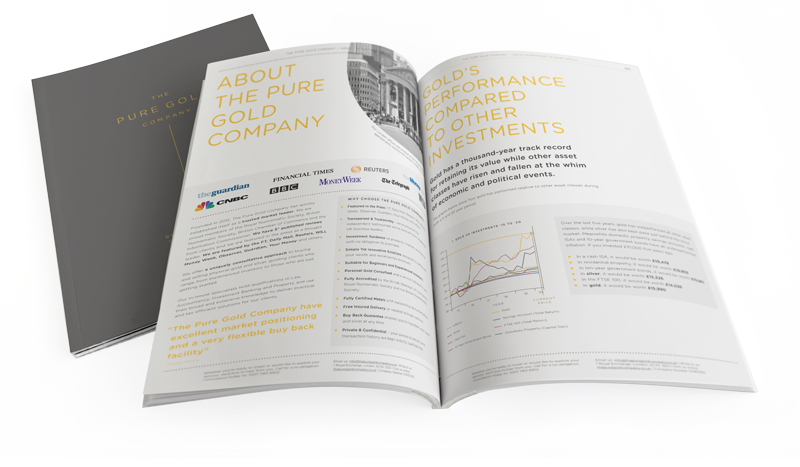For centuries, gold has been used as a currency and a store of wealth. It comes in various physical forms, from coins to jewellery to decorative objects. These physical manifestations were the only way for retail investors to own the safe-haven asset for centuries. In the 20th Century, stock market investing went mainstream, and alternative asset classes were devised.
What is paper gold?
These days, there are many ways to buy into gold without ever actually owning the physical metal. You can trade in Exchange-traded funds, Contracts for Difference, digital gold or mining stocks. All require no interaction with actual gold but track the gold price as it moves.
‘Paper gold’ can be used as a proxy for the real stuff. But, it’s essential to understand the pitfalls and the advantages when considering the type of gold that fits an investment portfolio.
Understanding Exchange Traded Funds
Gold-backed Exchange Traded Funds are funds in which you can trade shares like a stock. As the name implies, the shares are backed by underlying physical gold stores and track the gold price. In most cases, it’s unlikely that a holder of a gold-backed ETF would be in a position to cash in their shares for physical gold. The threshold for physical delivery is usually too high (over a million dollars for the most popular ETF). There is also scepticism about whether the funds hold the full gold equivalent to back up the shares in their fund.
Gold ETFs are a popular investment choice because they are very liquid and easy to trade, but they are not risk-free.
Even if you can’t liquidate your shares into gold, investors still have to rely on the fund to honour the investment. The fund is the first counterparty (opposite party in a financial transaction), that comes with the risk of default, but it’s not the last.The fund will use a financial institution to source and store the gold, which adds a second level of counterparty risk to the investment. There may also be further layers of counterparty risk in certain ETFs.
Counting up the cost
Although gold ETFs don’t attract spread charges, there are ongoing costs for holding the fund. There may also be trading charges depending on which platform and ETF is used. Unlike some forms of physical gold, ETFs also attract capital gains tax on the profit when sold. When considering a gold-linked investment, the risks and costs should be weighed alongside the liquidity benefits.
Contracts for Difference
Investors intent on avoiding owning a physical gold asset, even if by proxy in a fund, may choose to trade a Contract for Difference. This is an agreement between a buyer and seller to exchange the difference in the value of an asset over time. The buyer never has to own the asset (gold in this case). They can profit whether the price moves up or down, so long as they correctly predicted the direction of travel. This complex investment instrument is only suitable for experienced investors. Contracts for Difference comes with greater risk (of losses or counterparty risk) than trading ETFs or physical gold. CFDs may appeal to those with a higher risk profile who want to trade on gold price movements in either direction, but they are not for everyone.
Investing in gold mining stocks
Gold mining companies are another way to gain exposure to gold on the stock market. Listed mining shares are easily traded and reflect, in part, the fortunes of the gold price. But the actual spot gold price forms only a part of the value of a gold mining stock.
Investing in gold mining stocks is a riskier investment because it involves more than just the price of an ounce of gold. Investors also have to take on risks associated with management. Efficiency, profitability and other factors can affect share prices irrespective of the value of gold rising or falling.
Mining shares are suitable for investors who want exposure to stocks linked to the price of gold. They also reflect the corporate fortunes of the company. The highs are high, but the lows can be very low, which undermines the aim of investing in gold, namely safety and security.
Looking Into Gold Investment?
Book a FREE consultation with our expert brokers at The Pure Gold Company.

Understanding Digital Gold Investments
Digital Gold is an electronic form of currency that is based on units of physical gold. The owner of the digital gold has a claim on its physical counterpart but, more often than not, never chooses to ‘collect’ on the gold. Instead, digital gold can be held, sold, or used to make purchases.
Ultimately, digital gold has to be issued and underwritten by a company or institution. This adds substantial counterparty risk. Some digital gold is recorded in the same blockchain format as cryptocurrencies and is held as tokens in a digital wallet and sold on exchanges. This association with cryptocurrencies may be detrimental to its reputation. However, some investors argue that, unlike other cryptocurrencies, digital gold is backed by physical product. Some institutions sell digital gold within their own platforms. This offers a way for investors to own gold without the restrictions of coin or bar weight. The gold is never delivered. It is allocated to the investor as a fractional part of a larger 400-gram bar and can be bought or sold back to the provider digitally. This digital gold relies entirely on the counterparty to uphold its obligations, and it still incurs storage fees.
The physical gold advantage
Physical gold has inherent advantages that many paper gold investors overlook. Many investors aren’t aware of the ease with which physical gold can be bought or sold today. Some advisors may not be able to advise on physical gold, so default to paper gold guidance instead. Paper gold is often portrayed as cheaper and easier to own, but there are usually hidden costs. Ongoing management and trading fees for owning paper gold all add to the investment’s cost. In much the same way as physical gold incurs storage costs unless it is delivered.
VAT & Capital Gains Tax-free investment?
Physical gold is VAT free, and in currency coin format, it also incurs no Capital Gains Tax. Taking delivery of your gold or utilising storage within a secure vault removes the counterparty risks associated with paper gold. Physical delivery also removes your investment from the financial system altogether in a way that paper gold can never be. This is one of the most important advantages of physical gold. In the event of economic upheaval, the yellow metal still belongs to the investor. Owning the physical metal is the best way to utilise gold’s safe-haven status. Physical gold ownership ensures you benefit from gold’s security and long-term store of value.


